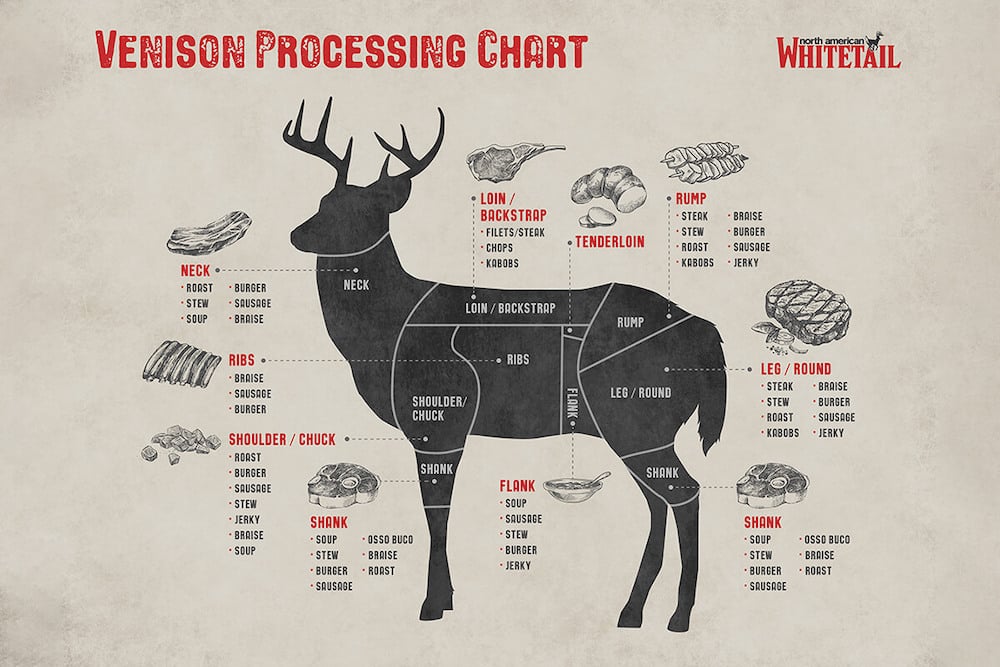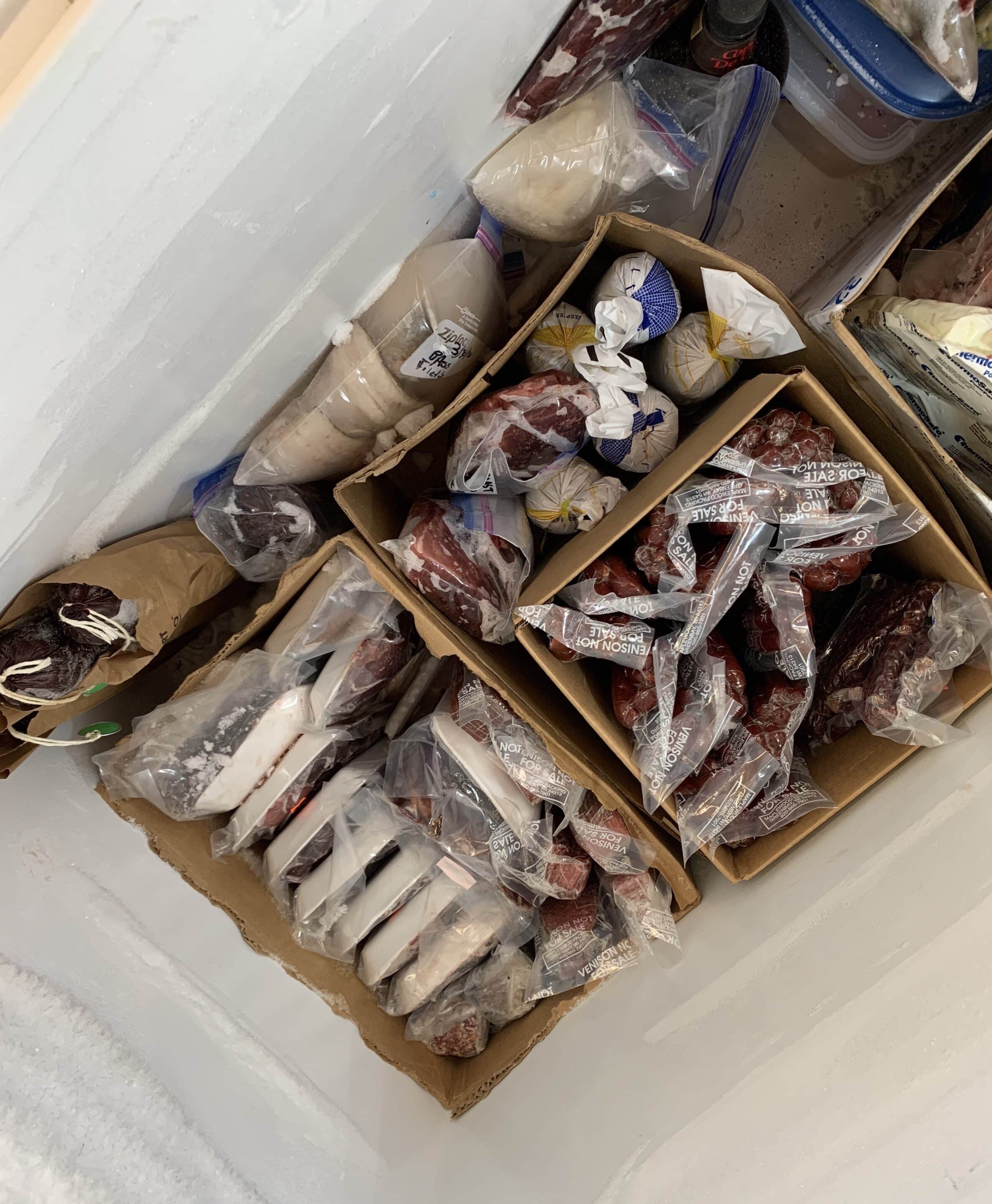Venison is the tasty reward bowhunters receive for a job well done. For many hunters, wild game is one of the main reasons they bowhunt. Wild game meat is healthy and nutritious. From steak to sausage, and burger to brats, venison is a versatile red meat.
It’s rewarding to experiment with ways to process meat. It opens up a world of new recipes. One way to prepare venison is by making bulk sausage, which is similar to ground meat like hamburger. It’s a term used for uncooked sausage without casings. Bulk sausage contains seasoning. Breakfast sausage is one type. It can be prepared by frying or making patties. It’s frequently used in sandwiches, tacos, biscuits and gravy, and more.
If you’re looking to spice up your freezer, here are some tips for making bulk venison sausage.

Review North American Whitetail’s venison cuts chart. Photo Credit: North American Whitetail / Outdoor Sportsman Group
Venison Trimmings: While you can use any cut of the deer to make bulk sausage, most people use trimmings. This will include leftover or tough cuts from the neck, shoulder and quarters. You don’t need to make the bulk sausage at the time of the harvest. Freeze these trimmings. If you harvest multiple deer or get together with friends, you can process all the sausage at the same time. North American Whitetail has an excellent deer diagram with all the cuts of meat and how to use them.
Pork or Beef Trimmings: Visit the local butcher to buy pork or beef trimmings. Venison is lean, and the trimmings serve as a binding agent. Many recipes call for a ratio of two parts venison, one part trimmings.
Seasoning: This is the fun part. There are a lot of options for sausage seasoning. It ultimately comes down to your taste buds. You can use a recipe and mix your own with ingredients you likely have stocked in the spice cabinet. You can also purchase pre-made seasonings from a variety of suppliers. Your nearby archery shop may carry supplies and seasonings.
Meat Grinder: Making sausage requires a quality meat grinder for the proper consistency. Some people use a dedicated meat grinder, while others choose to use a meat grinder attachment for a KitchenAid mixer.
Coarse and Fine Meat Grinding Plates: Many recipes call for grinding the meat twice to achieve the proper consistency.
Mixing Bowls or Plastic Tubs: Stainless-steel bowls help keep meat chilled.
Rubber Gloves: For safe food handling. Plus, your hands may get a little less cold.
Kitchen Scale: Helps you properly measure portions for storage.
Wild Game Meat Bags or Vacuum Sealer Bags: Proper meat storage is important. Meat can last two to three days in the fridge or several months in the freezer. Package it properly so it doesn’t spoil or suffer freezer burn.
Sausage Stuffer: This is an attachment for the meat grinder or KitchenAid. It’s not necessary, but it can make the process of filling meat bags go quicker.

Keep your venison cold. Photo Credit: BU
Make It in Bulk: You don’t need to make sausage after every hunt. Most hunters freeze the meat trimmings they plan to use for sausage. When hunting season is over and they’ve got some downtime, they pull out all the meat for processing.
Have a Party: Host a sausage-making event. Invite family or friends to bring any meat they need to grind. Helping hands makes the process quicker. It’s also a great excuse to catch up and swap stories after hunting season.
Sample Some Seasonings: From sweet to spicy, seasoning options are seemingly endless. Before you commit to a flavor, conduct some taste tests. If you have any friends or family with sausage recipes, ask to taste-test theirs. Visit a local store and purchase some bulk sausage for a taste test. Try to identify which ingredients you like, and those you don’t. You may also want to consider recipes you’ll use with the final product.
Keep It Chill: It’s essential to keep the meat cold and firm throughout the grinding process. Have the meat cubed and frozen before the sausage-making day. Don’t pull the meat from the freezer until you’re ready to grind. Some people choose to grind the meat frozen, while others prefer semifrozen. However you choose, it shouldn’t reach above 40 degrees. Some people even put their grinding equipment and bowls in the freezer to keep everything cool. Keeping the meat cool prevents the consistency from turning out more like paste.
Take Your Time: Making bulk sausage takes time. Don’t try to rush the process, or you’ll taste it in the results. Set aside a day where that’s the only thing on your plate. Your tastebuds will thank you if you take the proper time.
Get the Grind Right: This is often the most intimidating part of sausage making for beginners. Similar to taste, texture can involve a lot of trial and error to figure out what you prefer. Most professionals recommend a two-grind process, even for hamburger and bulk sausage. Start with a coarser grind, followed by a finer grind. Starting with a coarse grind puts less pressure on the machine. It will make the process quicker and more efficient. Following up with a second grind helps mix the spices.
The steps will vary based on preference and specific recipe.
Don’t be intimidated by the sausage-making process. Bulk sausage is a great way to get started since it requires few ingredients and supplies. The ease and versatility of bulk sausage provides quick, easy meals for your family and friends. Making sausage yourself with your harvest is truly field to fork. It allows you to care for the meat and control the flavor and fat content. Making bulk sausage is a great way to add variety to your meat stash and menu.